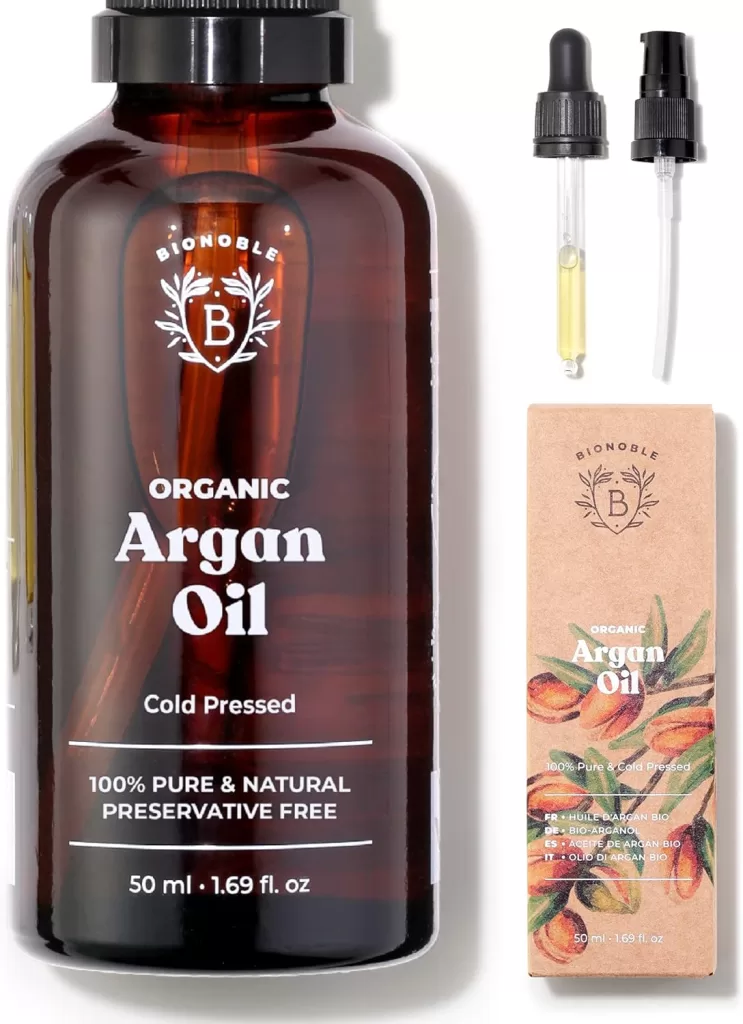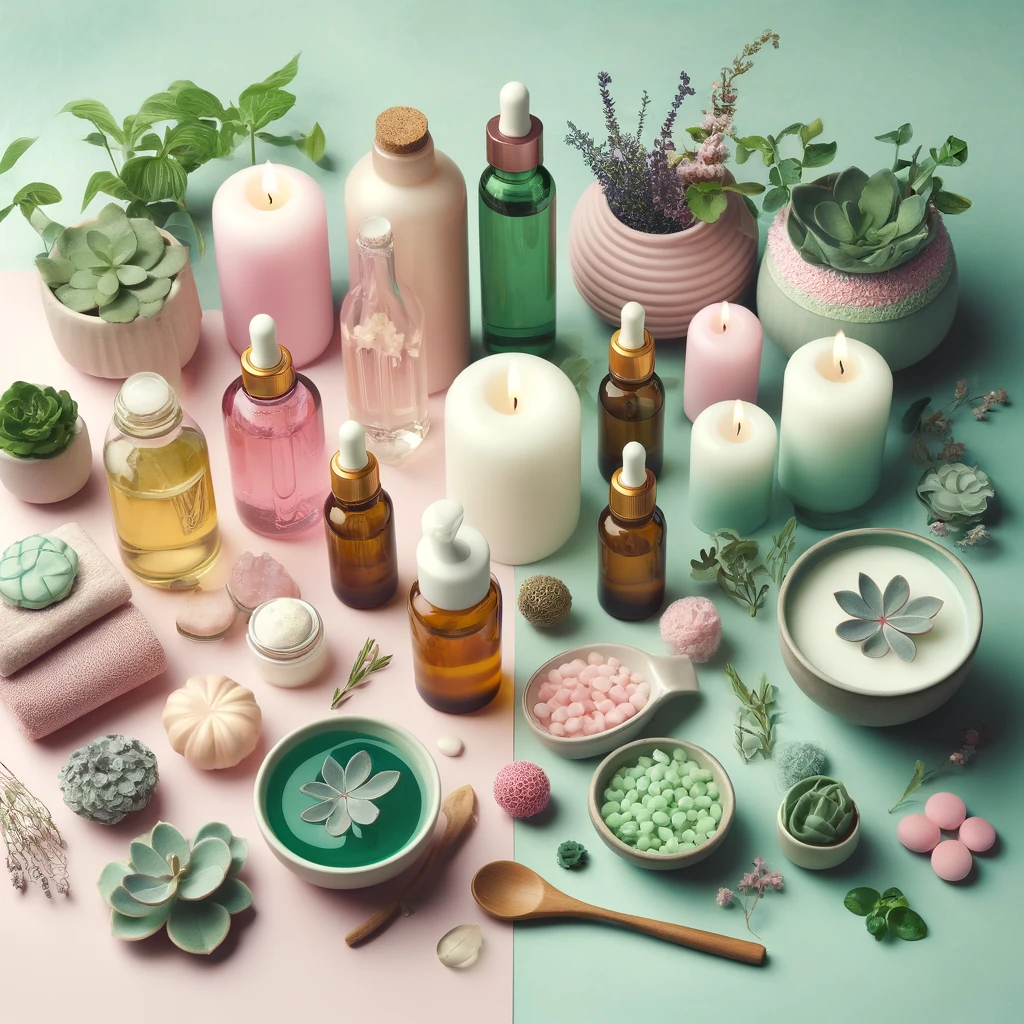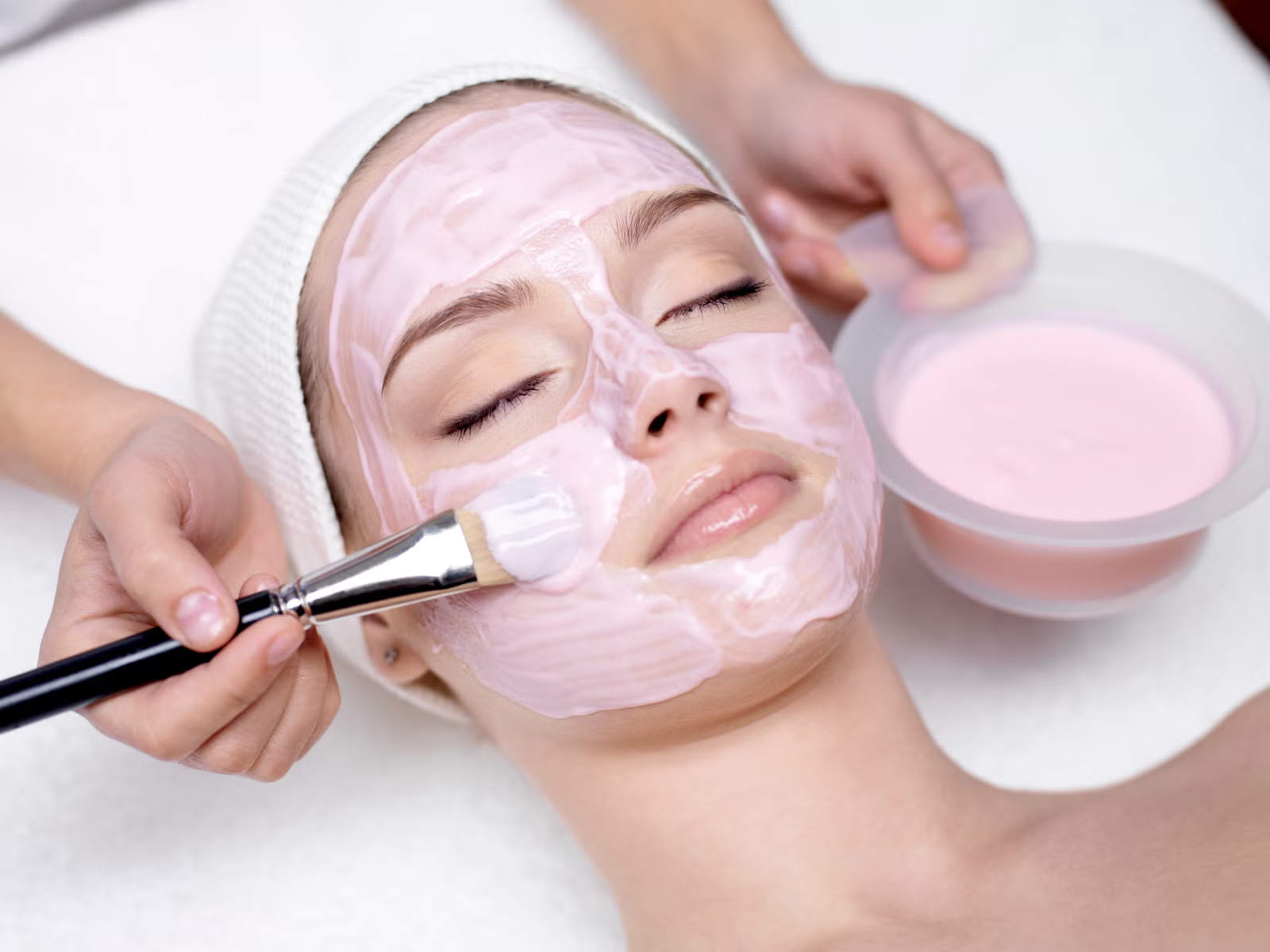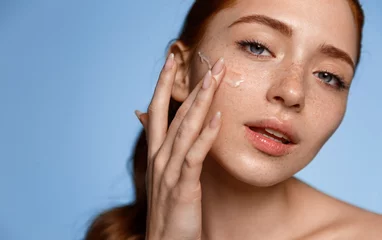Why Combine Body Lotion and Face Oil?
Mixing Body Lotion and Face Oil: When it comes to skincare, hydration is key, especially during colder months or if you have naturally dry skin. Combining body lotion with face oil is a powerful yet simple hack that amplifies moisture retention and leaves your skin soft, glowing, and hydrated. This method works by leveraging the lightweight hydrating properties of body lotion and the nourishing, lipid-replenishing qualities of face oil.

Bionoble Organic Argan Oil 50ml – 100% Pure, Natural and Cold Pressed – for Hair, Face, Body, Beard, Nails – Vegan and Cruelty Free – Glass Bottle + Pipette..
Discover the Benefits and Ingredients in Body Moisturizers
When choosing the right body moisturizer, it’s essential to understand how different formulas work and what ingredients they include. Here’s a guide to help you navigate the benefits and components of various body moisturizers, ensuring you find the perfect fit for your skin needs.
Intensive Moisturizing Lotion
Ideal For:
- Skin Type: Dry to Very Dry Skin
- Main Benefit: Provides deep hydration
Key Benefits:
- Relieves symptoms of dryness like itching, tightness, scaling, and redness.
- Quickly penetrates the surface layers of the skin, offering deep hydration without any greasy or sticky residue.
Star Ingredients:
- 5% Hydro-Urea: Delivers instant relief for extra dry skin.
- Ceramides: Helps rebuild your skin’s natural barrier, keeping moisture in and harmful elements out.
- Hyaluronic Acid: Helps maintain moisture balance for smoother, plumper skin.
Texture: Rich, non-greasy lotion
Moisturizing Cream
Ideal For:
- Skin Type: Normal to Dry Skin
- Main Benefit: Maintains hydration
Key Benefits:
- Supports your skin’s protective barrier, locking in moisture that lasts.
Star Ingredients:
- Ceramides & Hyaluronic Acid: Together, they enhance the skin’s natural moisture retention.
- Petrolatum: Creates a physical barrier that prevents moisture loss while soothing dry skin.
- Dimethicone: Conditions and improves skin softness and flexibility.
Texture: Cream
Healing Ointment
Ideal For:
- Skin Type: Dry to Very Dry Skin
- Main Benefit: Treats cracked and chafed skin
Key Benefits:
- Temporarily protects and hydrates as skin recovers from extreme dryness.
- Forms a protective layer, maintaining the skin’s moisture barrier for up to 8 hours.
Star Ingredients:
- Petrolatum: Seals in moisture and alleviates dry patches.
- Ceramides & Hyaluronic Acid: Enhance the barrier function and moisture balance.
Texture: Balm
Daily Moisturizing Lotion
Ideal For:
- Skin Type: Normal to Dry Skin
- Main Benefit: Everyday hydration
Key Benefits:
- Maintains the skin’s protective barrier with lasting moisture.
Star Ingredients:
- Ceramides & Hyaluronic Acid: Work together to lock in moisture and restore the skin’s barrier.
Texture: Lightweight Lotion
SA Lotion for Rough & Bumpy Skin
Ideal For:
- Skin Type: Rough & Bumpy Skin
- Main Benefit: Exfoliates and moisturizes
Key Benefits:
- Moisturizes while gently exfoliating to improve the texture of dry, bumpy skin.
Star Ingredients:
- Salicylic Acid & Lactic Acid: Promote the skin’s natural exfoliation for a softer feel.
- Ceramides & Hyaluronic Acid: Ensure moisture balance and support the skin’s barrier.
Texture: Lotion
Each moisturizer is uniquely formulated to address specific skin concerns with targeted benefits and carefully selected ingredients. Whether you need deep hydration or a gentle exfoliation, understanding these options will help you maintain healthy, nourished skin.
How Do Body Lotions and Creams Differ in Terms of Texture and Suitability for Various Skin Types?
When choosing between body lotions and body creams, understanding the key differences in texture and suitability can help you find the right fit for your skin type.
Texture and Composition
- Body Lotions: Typically, lotions have a higher water content, resulting in a lighter and thinner consistency. This makes them absorb quickly into the skin, leaving a refreshing, non-greasy finish. Their lightweight nature is perfect for those with oily or normal skin, as they provide hydration without heaviness.
- Body Creams: In contrast, creams are denser and richer due to a higher concentration of oils and emollients. This thicker texture takes a bit longer to absorb but offers more intensive moisturization. Creams are ideal for dry or mature skin, especially in colder climates where the skin tends to lose moisture.
Suitability for Skin Types
- Oily and Normal Skin: If your skin tends to be oily or sits in the normal range, a lotion’s lightweight formulation can offer adequate hydration without leaving a greasy residue. It’s a great option for daily use and warmer weather.
- Dry and Mature Skin: For those dealing with dry patches or mature skin, body creams deliver the deep nourishment that helps to replenish and lock in moisture. This can be particularly beneficial during the winter months when the skin is prone to dryness.
Ultimately, the choice between lotion and cream depends on your skin’s needs and environmental factors. Understanding these differences empowers you to tailor your skincare routine for optimal results.
Benefits of Mixing Body Lotion and Face Oil
- Deep Hydration:
Face oils penetrate deeper layers of the skin, locking in moisture while the lotion forms a protective barrier. - Enhanced Absorption:
Mixing oil with lotion creates a smoother consistency, making it easier for the skin to absorb. - Customizable Formula:
You can adjust the ratio based on your skin’s hydration needs or seasonal changes. - Glowing Skin:
The oil adds a radiant sheen, leaving your skin looking healthy and luminous. - Reduces Dryness and Flakiness:
Ideal for dry patches, elbows, knees, and any other areas needing extra attention.

CeraVe Moisturising Lotion for Dry to Very Dry Skin. A lightweight moisturising lotion for face and body that delivers instant & long lasting hydration, for up to 24 hours. For normal to dry skin. Also suitable for eczema prone skin.
When seeking effective body moisturizers for dry skin, understanding key ingredients can help you make the best choice. Here’s a breakdown of some essential components to look for:
1. Ceramides
Ceramides are lipid molecules found naturally in the skin’s barrier. They play a crucial role in retaining moisture and keeping harmful elements at bay. By restoring the skin’s protective barrier, ceramides help lock in hydration, making them a staple in many moisturizing products.
2. Hyaluronic Acid
Known for its impressive moisturizing properties, hyaluronic acid is a must-have ingredient. It helps maintain the skin’s moisture balance and provides a plump, smooth texture by attracting and retaining water in the skin.
3. Petrolatum
Petrolatum acts as an occlusive agent, forming a protective layer on the skin’s surface. This layer helps trap moisture and prevents transepidermal water loss (TEWL), making it highly effective for dry, flaky, or irritated skin.
4. Dimethicone
This silicone-based polymer helps condition the skin, improving its softness and flexibility. Dimethicone acts as an emollient to provide a smooth, silky feel without leaving a greasy residue.
5. Urea
Often used in treatments for very dry skin, urea is known for its hydrating and exfoliating properties. It penetrates the skin’s surface to provide deep hydration, relieving signs of dryness such as itchiness, flaking, and tightness.
These ingredients work in synergy to address various symptoms of dryness, providing relief and hydration. When choosing a moisturizer, look for products incorporating these components to ensure optimum care for your dry skin.
Best Face Oils to Use Based on Skin Type
| Skin Type | Recommended Face Oil | Benefits |
|---|---|---|
| Dry Skin | Argan Oil | Intense hydration and soothing properties |
| Oily/Combination | Jojoba Oil | Balances oil production, non-comedogenic |
| Sensitive Skin | Chamomile Oil | Calms irritation and reduces redness |
| Mature Skin | Rosehip Oil | Packed with antioxidants and anti-aging benefits |
| Normal Skin | Sweet Almond Oil | Lightweight and nourishing |

Explore Wellness Benefits of Beauty Products for Mind & Body
Beauty products offer more than just aesthetic benefits; they support both physical and psychological well-being. Research-backed ingredients and dermatologist-approved formulas enhance our appearance while promoting overall wellness. This guide will explore the benefits of including beauty products in self-care routines, choosing wellness-oriented options, and how these routines benefit mind and body. Olay Cleansing Melts
Choosing the Ideal Body Moisturizer for Mature Skin
Selecting the best body moisturizer for mature skin involves understanding your skin’s unique requirements. As skin ages, it becomes thinner and may lose some of its natural oils. Here’s how you can find the perfect match:
1. Identify Key Ingredients
- Hyaluronic Acid: This ingredient is excellent for retaining moisture.
- Glycerin: Known for its hydrating properties, it draws moisture to the skin.
- Ceramides: Essential for restoring the skin barrier.
- Retinol: Helps with skin renewal and improving surface texture.
2. Opt for Rich Formulations
Mature skin benefits from thicker creams or ointments. They not only hydrate but also provide a protective layer that locks in moisture.
3. Consider Sensitivity
Mature skin can be more sensitive. Look for products that are fragrance-free and hypoallergenic to minimize irritation.
4. SPF is a Must
Though primarily for daytime use, having a moisturizer with SPF can protect against age-accelerating UV damage.
5. Test and Adjust
What works for one person might not work for another. Start with small samples and observe how your skin responds before committing to a full-sized product.
By focusing on these factors, you can select a body moisturizer that nourishes, protects, and enhances the health of mature skin.
Which Moisturizer is Suitable for Smoothing Rough and Bumpy Skin?
When it comes to achieving smoother skin, especially if you’re dealing with rough texture or bumps, a moisturizer that contains exfoliating ingredients can be highly effective. Look for products with ingredients like salicylic acid and lactic acid, known for their ability to gently exfoliate and improve skin texture.
Key Ingredients to Look For:
- Salicylic Acid: Helps to exfoliate and remove dead skin cells, improving skin texture.
- Lactic Acid: Aids in gentle exfoliation, leaving skin softer and smoother.
Product Recommendations:
- AmLactin Daily Moisturizing Body Lotion:
- Contains lactic acid for effective exfoliation.
- Ideal for treating rough, dry skin.
- Gold Bond Rough & Bumpy Skin Daily Therapy Cream:
- Features a combination of exfoliating acids and moisturizers.
- Designed to smooth and soften skin.
- Eucerin Roughness Relief Lotion:
- Includes urea and lactic acid.
- Softens and smooths rough patches.
By incorporating one of these targeted moisturizers into your routine, you can help transform rough, bumpy skin into a smoother, more refined texture. Each option provides essential exfoliating benefits while deeply moisturizing, making them suitable choices for tackling stubborn skin issues.
How to Mix Body Lotion and Face Oil
- Choose Your Products:
Opt for a lightweight body lotion and a high-quality face oil suitable for your skin type. - Find the Right Ratio:
- For everyday hydration: Mix a dollop of lotion with 2-3 drops of face oil.
- For intense hydration: Add 4-5 drops of oil for extra richness.
- Mix Thoroughly:
Combine the lotion and oil in the palm of your hand until you achieve a smooth consistency. - Apply Strategically:
Focus on areas prone to dryness, such as elbows, knees, and legs, and massage until fully absorbed. - Let It Set:
Allow the mixture to sink into the skin for a few minutes before dressing to avoid transferring onto clothes.

Effective Solutions for Oily, Acne-Prone T-Zone: Face Masks and Toners
Oily T-Zone Breakouts Managing an oily T-zone that frequently breaks out can be challenging, especially when it feels like you’ve tried everything without success. To help you out, here’s a comprehensive guide on the best face masks and toners specifically formulated to control oil and reduce acne in the T-zone area. Understanding the Oily T-Zone…
When to Use This Technique
- Daily Routine: Apply after showering to lock in moisture.
- Before Bedtime: Use a richer mix at night for deep hydration.
- Seasonal Skincare: Perfect for winter when skin tends to lose moisture more quickly.
Purpose and Application of Ointments
Ointments serve as a powerful ally for anyone dealing with extremely dry skin. Their primary function is to deeply moisturize and create a protective barrier, which is particularly beneficial for areas that are prone to dryness and flakiness, like heels, knees, and elbows.
When to Use Ointments
- Severely Dry Skin: If your skin feels painfully dry or is visibly flaking, reach for an ointment to deliver intense hydration.
- Cracking and Chafing: When your skin has been through the wringer, from harsh weather or friction, ointments can soothe and aid in recovery.
- Preventing Diaper Rash: For the little ones, some ointments are formulated to prevent and treat diaper rash, offering gentle protection and moisture.
These products are inherently thicker and more occlusive than creams or lotions, containing high concentrations of emollients that lock in moisture. This makes them the go-to choice for anyone in need of serious hydration. Whether soothing dry patches or safeguarding sensitive skin, ointments are designed to provide relief and protection whenever your skin needs it most.
Tips for Maximum Absorption
- Exfoliate Regularly: Remove dead skin cells to allow the lotion-oil mix to penetrate better.
- Apply on Damp Skin: After a shower or bath, pat your skin dry and apply the mix to seal in moisture.
- Warm Up the Mixture: Rub the lotion and oil between your palms to slightly warm it for smoother application.

PraNaturals Dead Sea Salt Body Scrub 500G – Hydrating & Moisturising, Natural Oils & Minerals
Precautions
- Avoid using heavily scented or essential oils that may irritate sensitive skin.
- Perform a patch test if trying a new face oil to ensure there are no allergic reactions.
- Use sparingly if you have oily skin; focus on dry areas to avoid excess shine.
By mixing body lotion and face oil, you can revolutionize your skincare routine with minimal effort. This simple yet effective technique not only enhances hydration but also leaves your skin soft, smooth, and radiant year-round. Whether you’re preparing for winter or dealing with persistent dryness, this beauty hack is a must-try for achieving healthy, glowing skin.
FAQs: Boosting Body Lotion with Face Oil for Extra Hydration
1. Can I use any face oil with body lotion?
Answer:
Not all face oils are suitable for mixing with body lotion. Opt for high-quality, non-comedogenic oils like jojoba, argan, or rosehip oil. Avoid oils with heavy fragrances or essential oils that may irritate sensitive skin.
2. Will mixing face oil with body lotion make my skin greasy?
Answer:
Not if you use the right ratio. Start with 2-3 drops of oil per dollop of lotion and adjust as needed. Lightweight oils like jojoba or grapeseed are less likely to feel greasy and absorb quickly.
3. Can I use body oil instead of face oil for this mix?
Answer:
Yes, body oils can work too. However, face oils are often formulated with more concentrated, skin-beneficial ingredients. Using face oil allows you to target specific skin concerns like dryness or dullness more effectively.
4. How often should I mix face oil with my body lotion?
Answer:
You can use this mixture daily, especially after a shower when your skin is most receptive to hydration. Adjust frequency based on your skin’s needs—use more during winter or when your skin feels particularly dry.
5. Can I use this method on my face as well?
Answer:
Yes, you can use this method on your face, but it requires extra care and consideration. Facial skin is more delicate and sensitive than body skin, so the products you choose and how you use them matter significantly.
Product Differentiation
- Facial vs. Body Products:
- Facial products are specifically formulated to be lighter, non-comedogenic (won’t clog pores), and suited to the thinner, more sensitive skin on your face.
- Body products are often thicker and may contain ingredients that are too heavy or irritating for facial skin.
- Key Ingredients to Look For:
- Hyaluronic Acid: Hydrates without heaviness.
- Niacinamide: Helps with redness and pore size.
- Ceramides: Strengthen the skin barrier.
- Non-Comedogenic Oils: Such as squalane, jojoba, or rosehip oil.
Product Examples
Here are some examples of products that work well for facial use:
- Moisturizers:
- CeraVe Facial Moisturizing Lotion (for normal to dry skin).
- Neutrogena Hydro Boost Water Gel (for oily or combination skin).
- La Roche-Posay Toleriane Double Repair Face Moisturizer (for sensitive skin).
- Facial Oils:
- The Ordinary 100% Plant-Derived Squalane (lightweight and hydrating).
- Herbivore Botanicals Lapis Facial Oil (for acne-prone skin).
- Biossance Squalane + Vitamin C Rose Oil (for brightening and hydration).
Label Importance
When choosing products for your face, always check the label for:
- Non-Comedogenic: Ensures the product won’t clog pores.
- Fragrance-Free: Reduces the risk of irritation.
- Hypoallergenic: Minimizes the chance of allergic reactions.
- Dermatologist-Tested: Indicates the product has been tested for safety on skin.
Additional Tips for Facial Application
- Patch Test: Always test a small amount of the product on your jawline or behind your ear to check for irritation.
- Less is More: Use smaller amounts of product, as facial skin absorbs quickly and can become overwhelmed.
- Layering Order: Apply lighter products (like serums) first, followed by heavier ones (like oils or creams).
Additional Resources
For those interested in exploring this topic further, here are some helpful resources:
- Guide to Choosing Facial Moisturizers for Different Skin Types:
- How to Choose the Right Moisturizer for Your Skin Type
- This guide breaks down the best ingredients and formulations for dry, oily, combination, and sensitive skin types.
- Understanding Skincare Ingredients:
- Paula’s Choice Ingredient Dictionary
- A comprehensive resource to learn about the benefits and potential irritants in skincare products.
- Consult a Dermatologist:
- If you have specific skin concerns (e.g., acne, rosacea, eczema), consulting a dermatologist can help you tailor your routine.
By following these guidelines and using the right products, you can safely adapt this method for your face while keeping your skin healthy and glowing.
6. Is this method suitable for all skin types?
Answer:
Yes! For oily skin, stick to lightweight oils like jojoba or grapeseed. Dry skin benefits from richer oils like argan or sweet almond. Sensitive skin may prefer calming oils like chamomile or rosehip.
7. Should I use this before or after sunscreen?
Answer:
Always apply sunscreen as the final step in your skincare routine. Use the lotion-oil mix after cleansing and before applying sunscreen for daytime use.
8. Can I mix face oil directly into my lotion bottle?
Answer:
It’s better to mix small amounts in your hand before application. Pre-mixing in the bottle can alter the lotion’s consistency and may reduce the shelf life of the product.
9. Are there any specific areas to focus on with this mixture?
Answer:
Yes! Pay special attention to dry-prone areas like elbows, knees, heels, and hands. The mixture also works wonders on legs, especially for a post-shower glow.
10. Can I add other ingredients to the mixture?
Answer:
For added benefits, you can include a drop of vitamin E oil for extra nourishment or aloe vera gel for soothing properties. However, keep the formula simple to avoid irritation or reduced efficacy.
Why You’ll Love This Skincare Hack
By mixing face oil with body lotion, you can achieve:
- Long-lasting hydration.
- Soft, glowing skin.
- A customizable routine that adapts to your skin’s needs.
Say goodbye to dry, lackluster skin and hello to a silky, smooth complexion!

Unlock Your Skin’s Radiant Potential: 5 Best Moisturizers After Vitamin E Oil
Moisturizer After Vitamin E Oil: Top Picks & Tips Understanding your skin type is crucial when selecting a moisturizer to use after Vitamin E oil. Vitamin E oil is a potent antioxidant that helps in repairing skin and protecting it from environmental stressors. However, since it’s a thick, oil-based product, it’s essential to follow up…

Explore more articles like this @ Where And How Resources
If you found this article helpful, don’t forget to share it with your friends and followers!

